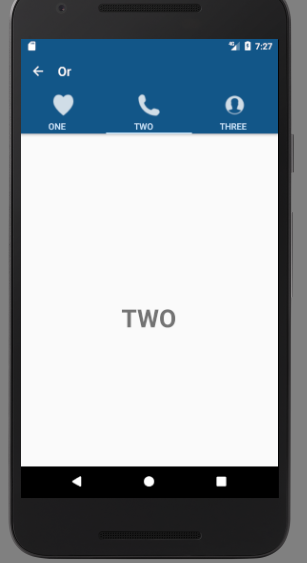

app:layout_scrollFlags="scroll|enterAlways" Read TYL 17.android:fitsSystemWindows="true" Read TYL 15.But if we don’t follow this hierarchy, the scroll events or UI elements might behave in a strange way. So, by using the correct hierarchy, we can now play with scroll events for the toolbar, due to the use of CoordinatorLayout.
#Tabview inside fragment how to
You will see later how to use this class. This class handles the displaying of the list of items and tabs.
#Tabview inside fragment code
Another wrong example, that I did in a project of mine, was that I used CoordinatorLayout as root view instead of DrawerLayout. And because of that, the navigationView was not being opened over the status bar.Also, you have to keep in mind that FrameLayout (the container) will be replaced in Java code with ContainerFragment.java fragment.

If you embed DrawerLayout inside other layout (let’s say a RelativeLayout as root view) and you place other UI components outside the DrawerLayout, those UI components will overlap the NavigationView when opened like below: In the image below, we have described the hierarchy of the views (which view contains which view).Īs you can see, DrawerLayout is the root view of this layout and this is the correct way to do it. In this xml file we will set the NavigationView, toolbar and tabs, using CoordinatorLayout.
#Tabview inside fragment android
It contains 2 texts and an icon (this file is taken from the NavigationView project from Android Studio Templates). Under res – layout create a new xml file and name it nav_header.xml. This layout will be added as header to the NavigationView. Using the methods setText(int) and setIcon(int) we set the title and icon of TabLayout respectively. To display this tab over the layout, we need to add this tab using addTab(Tab) method. The tabs for the TabLayout is created using the newTab() method. Go to res – values – dimens.xml and add the following code. Android TabLayout is a Layout which is used to build horizontal tabs. Now, we will have to create a menu directory in which we will have to create a xml file containing the NavigationView items.Īdd the following strings to res – values – strings.xml android:statusBarColor: this will make the status bar transparent when the NavigationView is opened.ProguardFiles getDefaultProguardFile('proguard-android.txt'), 'proguard-rules.pro'Ĭompile fileTree(dir: 'libs', include: )ĪndroidTestCompile('.espresso:espresso-core:2.2.2'. TestInstrumentationRunner ".AndroidJUnitRunner" In the app module directory, open the adle file and add ‘:design:24.0.0’ to dependencies. setup NavigationView in MainActiviy.java.set TabLayout and NavigationView in the activity_main.xml.create the xml file for the NavigationView’s header.add dimensions for NavigationView’s header in dimens.xml.handle theme setup in values-v21 – styles.xml.handle theme setup in values – styles.xml.add compile ‘:design:24.0.0’ to dependencies in adle.Switch the visibility of project structure by selecting “Project” option like in the image below.įirst, we will create the NavigationView like explained further in the tutorial.Create a new project by choosing the empty template and then click the Next button until the project is created.In this tutorial we will create a simple app which has a NavigationView, a Toolbar with Tabs and a simple list of items, that are displayed for each selected tab.


 0 kommentar(er)
0 kommentar(er)
